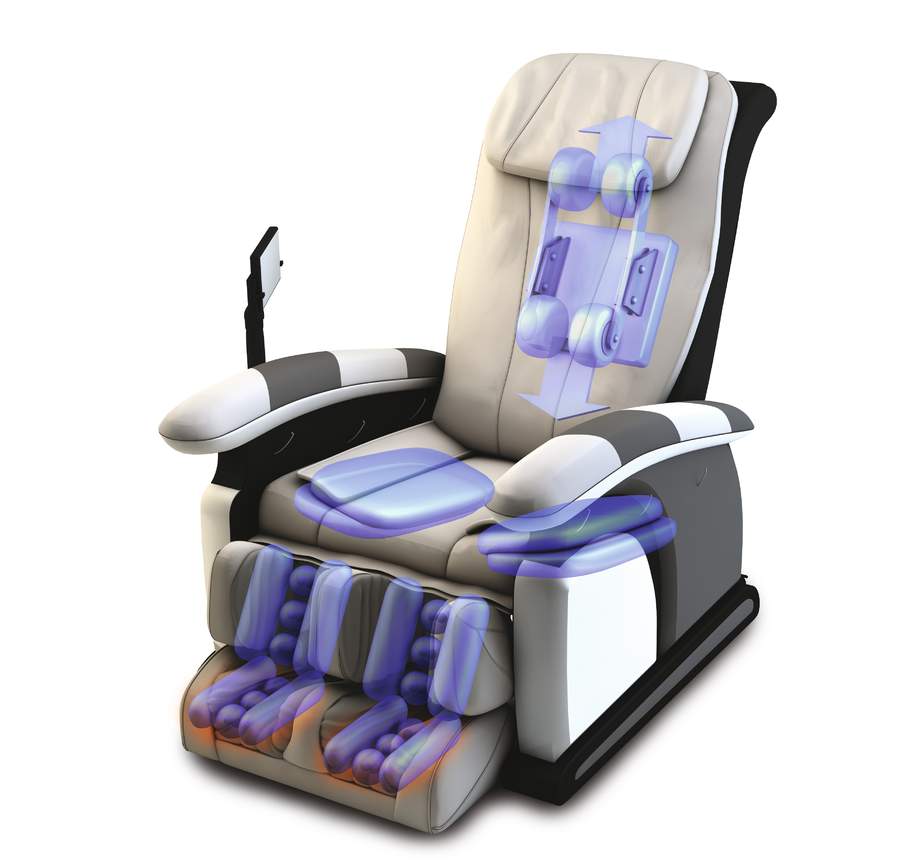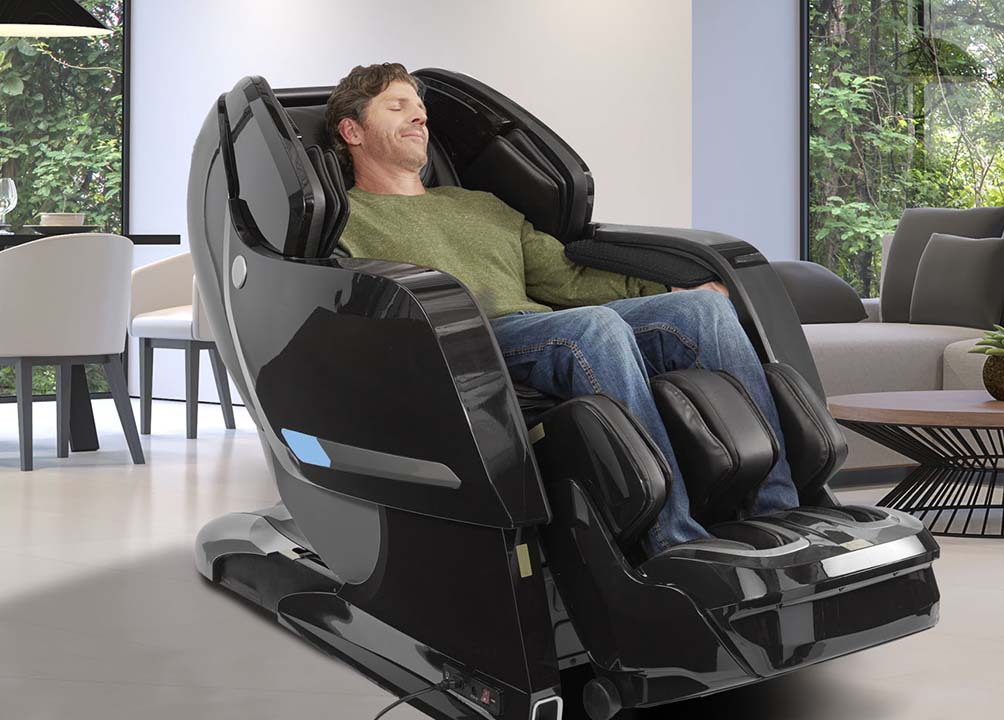Are you curious to learn the science behind how massage chairs work? This guide will not only provide the technical knowledge but also help you to make an informed purchase when shopping for a massage chair.
Discover how this amazing technology can help you relax and unwind, while learning why massage chairs are a great investment. You’ll be glad you read this!
Massage chairs are becoming increasingly popular as a means of achieving relaxation, improved circulation and manual therapy. The science behind how massage chairs work makes use of advanced technology to replicate the skills and knowledge of massage therapists and provide users with an automated massage experience.
This guide will delve into the anatomy physiology behind how massage chairs work. It will cover the various technological components employed in creating a massage chair, what muscles it targets and how it mimics certain techniques used by masseuses, reflexologists and physical therapists. By understanding the inner workings of a massage chair, you can have more confidence in using it to its full potential.
Definition of massage chairs
Massage chairs are chairs designed specifically for therapeutic massage. They can be used in the comfort of your own home or by professional massage therapists in massage parlors or spas.
Massage chairs use a range of mechanical and electronic features to simulate various massage techniques, such as Shiatsu, rolling, kneading, Swedish, reflexology and tapping.
The object of all these techniques is to affect the muscles and other soft tissue to relieve stress, tension, improve circulation and reduce muscle fatigue. Different massage chair models can offer different levels of intensity, ranging from light to intense vibration. Some offer heating functions for additional relaxation effects.
The rollers used for massage technology come in different sizes and materials – softer rollers for gentle effects on the body or larger rollers for deeper tissue manipulation. Most modern chairs are equipped with artificial intelligence (AI) systems that enable them to analyze body types and adjust the pressure and intensity accordingly.
Some come with nighttime lighting patterns such as sunset/sunrise simulation to help transition you into sleep when done with your session.

How massage chairs work
Massage chairs are designed to replicate the effects of a professional massage using mechanical systems and technologies. Generally, massage chairs are equipped with motors, compressors, and robotic systems that move parts of the chair in order to offer various massages.
The two main components that make up most massage chairs are the roller track and air bags. The roller track is a long track located at the back of the chair which houses mechanical rollers that move along the spine. The rollers can be adjusted for varying pressure and area of focus on the chair’s users back. The air bags are Compressor powered airbags which inflate or deflate in sequence with one another, allowing them to compress areas such as your arms and legs, producing a squeezing action on these parts of your body. This helps muscles relax and eases away tension experienced by users.
Many massage chairs also include features such as heat therapy, shiatsu rollers, reflexology footpads and automated massage sessions which simulate techniques used by various different professionals types including Shiatsu therapists as well as Tuina practitioners. These features can help improve blood flow throughout your body while also providing additional relaxing sensations beyond what traditional hands-on massaging provides.
Mechanisms and components of a massage chair
To gain a better understanding of how massage chairs work, it is important to recognize the various mechanisms and components present in them. The main components involve a system of pistons and gears which provide the mechanical pressure that serves as the basis for massage. This includes a range of components, such as compression cylinders and sensory feedback mechanisms, that act together to provide the desired kneading, tapping, shiatsu and other kinds of massages.
The roller system is what gives massage chairs their power. The construction of this system consists mostly of dedicated roller tracks with adjustable gears in order to ensure optimal coverage as well as intensity levels ranging from light to deep tissue massage. As its function suggests, this type of mechanism allows for targeted movements of soft tissue without any manual intervention by a therapist.
The most important aspect present in many advanced models is the use of airbag technology which serves to complement the rollers and allow for squeezing motions during whole body massages. These airbags should be designed with extra-strength materials such as PVC plastic sheets or even heavy-duty fabric in order to withstand bursts caused by extreme pressure on sensitive areas. Some additional features may also include sensors located under the upholstery so they can measure depth and area pressure points accurately before beginning any kind of massage program!
The science behind massage techniques used in massage chairs
Massage chairs employ a range of massage techniques that can be broken down into two categories: mechanical and physiological. Mechanical massage involves the application of rhythmic pressure to the body’s soft tissues such as muscle, ligament, tendons, joint capsules and circulatory channels as well as stimulation such as tapping, kneading, pressing and rolling. Physiological massage focuses on the systems that control an individual’s body such as circulatory and lymphatic systems.
Different types of mechanical massage techniques used in massage chairs include vibrational, oscillatory, pressure-shuttling and pressurized-pulsed techniques. Vibrational techniques involve movement at a very fast rate which shakes or stimulates the body’s soft tissues. Oscillatory techniques involve movements in back-and-forth motion which can penetrate deep into the tissue to enhance blood circulation in surrounding areas. Pressure shuttle technique involves precision rhythmic movements with each movement further divided into fractions based on pressure put by chair upon user’s body each time it moves. Pressured pulsed techniques involve low intensity single spikes vibrations used for relaxing muscles associated with chosen area along with helping to alleviate tension and fatigue from those muscles effectively.
Physiological massage addresses underlying physiological mechanisms through manipulating neural connections with thoracic spinal cord which reside at neck level within most individuals thus regulating their bodily functions like digestion, bodily fluid secretion etc., Manipulating these connections via massaging certain areas connected to them will help to improve efficiency of bodily functions thus further impacting overall health condition positively. Reflexology is one prominent example of physiological massage wherein certain areas of feet are massaged to increase circulation towards organs connected to those points thus enabling better functioning after much needed relaxation period.
How massage chairs stimulate muscles and nerves
Massage chairs apply pressure to various parts of the body, manipulating muscles and nerves by incorporating elements such as kneading, tapping and rolling through specialized mechanical components. By integrating advanced technology and ergonomic engineering, massage chairs provide a range of massage techniques to help alleviate stress, improve posture and relaxation.
Various components power the massage functions of a massage chair – airbags that inflate and deflate, rollers that move back and forth in specific patterns across the body, motors that turn parts at different speeds for different effects. The combination of these functions creates a range of highly customizable massages from light relaxation techniques to intense deep tissue work.
Rollers are one of the key components used in most massage chairs. These rollers are controlled by sophisticated microprocessors which manipulate the speed, direction and intensity based on a preset program. The rollers glide across the user’s back in an S-shaped pattern designed to accommodate how bodies move naturally through space while providing a gentle massaging action that can penetrate deeply into muscle tissue.
Airbags are another integral component found in many massage chairs today. As part of its complex programming system, airbags inflate and deflate independently to quickly target tension points along the neck, shoulder or lower back for increased comfort. This technique works as an external form of acupressure as pressure is applied along specific points within muscles or along nerve pathways for increased relief from stiffness or pain.

Benefits of using massage chairs
Massage chairs are designed to provide several health benefits. Research has shown that massage therapy offers a variety of physical, mental and emotional benefits, including:
- Stress reduction and relaxation. Regular use of a massage chair can help to manage stress levels. Massage therapy encourages the body to release endorphins, the feel-good chemicals in the brain which have a calming effect.
- Improved circulation. Massage chair movements stimulate circulation by increasing blood flow in targeted areas of the body. This can help to reduce pain, stiffness and discomfort while also providing healing and nourishment to the muscles.
- Relief from lower back pain. Sitting for long periods of time can cause tension in the back muscles which results in pain and discomfort. A massage chair helps loosen tight muscles which increases mobility and helps you achieve an upright posture with less pain.
- Reduced anxiety or depression symptoms. Regular massage sessions can help reduce symptoms of anxiety and depression by lowering cortisol levels (the stress hormone). It can also boost serotonin production which acts as a natural antidepressant in the brain.
- Increased energy levels. Massage therapy increases your body’s oxygen levels which releases toxins more quickly, therefore boosting energy levels significantly after prolonged use.
Physical benefits
Massage chairs provide a broad range of physical benefits, ranging from improved circulation and muscle relaxation to improved posture and body alignment.
Massage chairs use special built-in massage techniques such as kneading, tapping, rolling and shiatsu to relax tense muscles and increase circulation to help reduce stress, fatigue and muscle stiffness. Additionally, they can also be adjusted to individual users’ needs, offering targeted therapy for specific areas or even full body coverage.
With regular use of a massage chair, individuals experience reduced feelings of stress as well as improved energy levels due to improved circulation. Moreover, the use of massage chairs aids in the prevention of injuries caused by poor posture or overly tight muscles by helping people maintain natural body alignment.
Finally, massage chairs can be used for tension-alleviation that allow people to enjoy relaxed muscles on a regular basis which ultimately leads to an overall feeling of wellbeing.
Psychological benefits
Besides the physical health benefits from massage chairs discussed above, there are also psychological benefits that can be felt when using a massage chair regularly. Massage chairs provide an excellent way to relax, relieve stress and tension and improve overall mood.
Many types of massage therapy have been shown to have positive effects on stress, mental fatigue, depression and anxiety in both clinical research studies and everyday life. During a massage session, endorphins (the body’s natural painkillers) and dopamine (the feel-good hormone) are released into the body. An increase in these hormones causes a decrease in cortisol (the main stress hormone). As a result, one feels less stressed mentally after a session with their massage chair.
Massage chairs can also help to promote better sleep patterns as well as help alleviate depression symptoms. By providing an alternate option for relaxation and promoting overall mental wellness, massage chairs can contribute to feelings of contentment, peace of mind and well-being.

Maintenance and care of massage chairs
Owning a massage chair is a great way to relieve stress and improve your overall health, but it requires some maintenance and care to keep the chair in working order. Regular maintenance of your massage chair can help extend its lifespan, increase its therapeutic benefit, and help prevent minor repair issues down the road.
There are a few simple steps you can take to make sure your massage chair stays in proper working condition:
- Periodically inspect each component and replace or repair pieces as needed. Pay close attention to moving parts such as actuators, brakes and motors.
- Clean all upholstered areas with non-abrasive cleaners like rubbing alcohol or diluted detergent when needed.
- Check the manufacturer’s user manual for any special advice such as recommended oiling intervals for specific parts or other recommended steps for maintaining the equipment.
- Prevent dust buildup by wiping down surfaces regularly with a soft cloth.
- Tighten any loose bolts if necessary.
- Keep liquid spills away from electrical components at all times to avoid shorting out the unit.
We also recommend bringing your massage chair in for professional servicing yearly or biyearly to ensure that it is running safely and effectively over time.
Tips for keeping your massage chair in good condition
Maintaining a massage chair is an important part of ensuring it functions properly and extends its lifespan. Massage chairs are complex pieces of machinery that rely on a variety of motors and mechanics, so careful maintenance is key to keeping them working smoothly. Below are some tips to help you keep your massage chair in top condition:
- Inspect your chair regularly for any signs of damage or wear and tear. Check the upholstery, controller, and all the mechanical parts for any malfunctions or breaks.
- Clean the upholstery regularly with mild soap and warm water to keep it looking new. To help mask normal wear, use a furniture protector over the sitting area.
- If possible, try not to move your massage chair once it is set up as excessive movement can increase the risk of mechanical damage over time.
- Make sure all AC cords are tucked away from pets or children who may inadvertently pull them out and cause damage to the motor or headrests.
- Keep pets out of massage chairs if possible as their claws can get caught in the mechanism and cause potential damage to them and/or user injury from jolting movements.
- When not using your massager for extended periods of time, power it off at its wall socket so there isn’t unnecessary strain placed on any component while not in use.
- Read through user manuals carefully while familiarizing yourself with all aspects of your product before use so you know how to properly operate it in order to get maximum benefit without causing any damages along the way.
Cleaning and maintaining your massage chair
Cleaning your massage chair is important to keep dust, dirt, and other debris from collecting on the surfaces of the massage chair. Additionally, you may want to spot clean your massage chair to remove any potential stains or spills that can occur over time. Keeping your massage chair clean also extends its life span and helps protect its value in the long run.
When cleaning your massage chair, use lukewarm water and a mild dish soap. Never use abrasive cleaners or scented detergents on your massage chair as they can damage the material it is made out of. To avoid damaging any of the moving parts of your chair, be sure not to submerge it in a bathtub or any other liquid-filled container. Instead, take a soft cloth and dampen it in soapy water and use this to wipe down every surface of your massage chair. Once you have done this, use another cloth wet with clean water to rinse off all traces of soap residue from the surfaces. Then dry off each surface with a third cloth that is completely dry.
It is also important to maintain both mechanical and electric components of you massage chair from time to time including: checking all power cords for fraying; adjust levers that control firmness levels; check screws for looseness; check for signs of wear and tear; make sure moving parts move easily and smoothly; lubricate any movable joints; check electrical connections for dirt or dust buildup; reset computerized controllers if necessary; check airbag connections if applicable etc. Be sure to refer to the owners manual provided with your specific model when performing these maintenance checks as some models may differ in terms of maintenance requirements. If you are uncomfortable with doing these tasks yourself be sure contact either the manufacturer or an authorized repair service provider for assistance if needed.

Conclusion
In conclusion, massage chairs work by using a combination of mechanical processes. These include vibrational and percussive massage methods, as well as automated robotic applications. Technology has allowed massage chair manufacturers to develop increasingly sophisticated massage programs capable of delivering a wider range of health benefits.
From relieving tension and stress—including those associated with chronic pain conditions like fibromyalgia—to improving range of motion, posture, circulation and overall relaxation; modern massage chairs may help most people enjoy the many healing benefits of professional-grade massage therapy while in the comfort and convenience of their own home.
It is important to keep in mind that even though massage chairs offer many health benefits, they should always be used responsibly and under the supervision of a medical doctor or other qualified healthcare professional when necessary.
FAQS
How does a massage chair system work?
A massage chair system typically includes rollers or airbags that provide pressure to specific areas of the body, such as the back and legs, and may also include heating or vibration features to promote relaxation and reduce muscle tension.
Do massage chairs work science?
Yes, there is scientific evidence to support the use of massage chairs for reducing muscle tension, promoting relaxation, and improving circulation.
How does a vibrating massage chair help?
A vibrating massage chair can help reduce muscle tension and promote relaxation by stimulating the muscles and increasing circulation.
What is massage chair technology?
Massage chair technology includes a variety of features and settings designed to simulate the experience of a traditional massage, including rollers, airbags, heating elements, and vibration.
Is massage chair healthy?
Yes, using a massage chair can be a healthy way to reduce stress, improve circulation, and relieve muscle tension.
What are the disadvantages of a massage chair?
Some potential disadvantages of using a massage chair may include the high cost, limited range of motion compared to a human massage therapist, and the potential for the chair to malfunction or break down.
How long should you sit in a massage chair?
The length of time to sit in a massage chair will depend on individual preferences and needs, but it is generally recommended to limit use to 15-30 minutes per session.
Why do massage chairs squeeze your legs?
Massage chairs may use airbags to squeeze the legs to provide pressure and stimulate circulation in the muscles.
Does massage chair consume electricity?
Yes, massage chairs require electricity to operate and may consume varying amounts of energy depending on the model and features.
What are three benefits of chair massage?
Three benefits of chair massage may include reduced muscle tension and soreness, improved circulation, and reduced stress and anxiety.
See Also:
- Best massage chair
- Best portable massage chair
- Best kahuna massage chair
- Best osaki massage chair
- Best heated massage office chair


